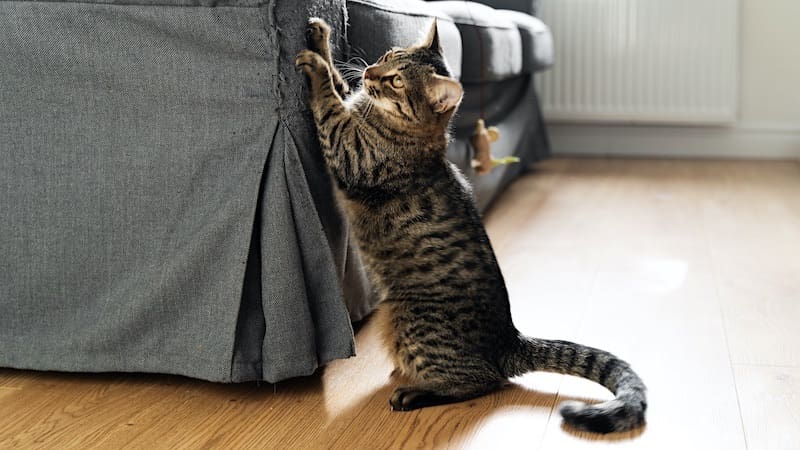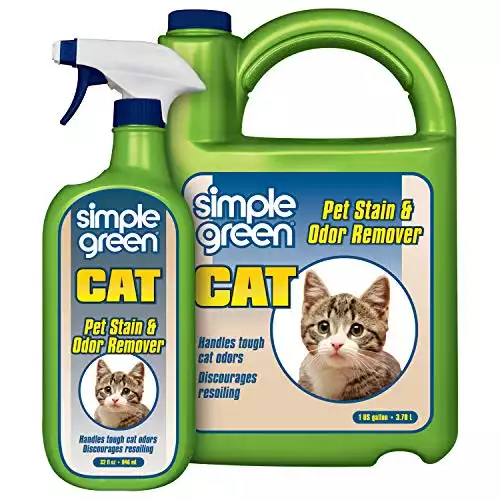Are you an indoor cat owner struggling to keep your furniture free of scratches and pet stains? If so, then you may want to consider trying a cat repellent spray that can help you keep cats off the furniture.
From natural solutions like citronella oil, vinegar and peppermint oil to commercial products designed specifically for this purpose, there are a variety of cat repellent sprays available that can help stop your pet from scratching or peeing on your couch.
Here we’ll discuss how understanding feline behavior is key in preventing these issues as well as provide tips on training your cat not to scratch or pee on the furniture and cleaning up after they have caused damage. So if you’re looking for ways to use spray to keep cats off furniture, read on.
Understanding Cat Behavior

Why Do Cats Scratch Furniture?
Cats scratch furniture for many reasons, including marking their territory, stretching their muscles and claws, and relieving stress. Cats employ scratching as a way to communicate with other felines in the vicinity.
They may also be attracted to certain fabrics or textures of furniture because they provide an appealing surface to do it on. In some cases, a cat may even be trying to get your attention if they feel neglected or bored.
What Are the Signs of Stress in a Cat?
When a cat is under stress, one may observe certain behaviors such as overgrooming, avoiding people or other animals, changes in eating and sleeping habits, aggression towards humans or other pets at home, excessive meowing/vocalizing and inappropriate urination/defecation outside of the litter box.
How Can I Discourage My Cat from Scratching Furniture?
The best way to discourage your house cat from scratching furniture is by providing them with appropriate alternatives such as posts covered with sisal rope, which provides an ideal texture for them to scratch against without damaging any furnishings.
Provide your feline with a range of playthings such as a cat tree to keep them amused and reduce anxiety levels. Additionally, try using deterrents like double-sided sticky tape or aluminum foil on areas where you don’t want them to scratch – this unpleasant sensation on their paws will remind them not to do it again.
Finally, ensure that you give your cat enough mental stimulation throughout the day by playing interactive games with them; this will keep their minds occupied while helping build a stronger bond between you both.
Understanding cat behavior is essential for owners who want to keep their cats from scratching at furniture. Herbal spritzes and citrus-based deterrents are an excellent way to deter your cat from engaging in undesirable conduct.
Recap: Providing a cat with appropriate alternatives such as sisal-rope covered posts, plenty of toys and interactive games can help discourage them from scratching at your furniture.
Additionally, using deterrents like double sided sticky tape will give a cat a reminder not to scratch the wrong surfaces again. With these methods in place, you’ll be able to keep your feline friends off the furniture for good.
Natural Solutions to Keep Cats Off Furniture
Cat repellent sprays are a great way to stop your indoor cat from scratching furniture. Cats possess a powerful olfactory sense, thus fragrances such as lavender, peppermint and citronella can be beneficial in keeping them away from furniture they should not access.
You can make an homemade spray using essential oils or diffusers to disperse the scent around your home and discourage your cat from getting near your furniture. Additionally, you can apply diluted essential oils directly onto the fabric of your furniture using a cotton ball or spray bottle for extra protection.
I had success by adding some peppermint oil to my usual counter top cleaner. I couldn’t really notice the peppermint odor but my cat suddenly stopped jumping onto them once I had done this.
Herbal sprays are another effective way to discourage your cat from peeing on furniture. Cat repellent sprays that contain natural ingredients such as lemon grass oil and cayenne pepper will make it unpleasant for your cat to go near certain pieces of furniture without harming them in any way.
Spray these herbal solutions liberally around areas where you don’t want your cat going and reapply every few days until they get used to staying away from those spots.
Citrus-based repellents are also useful for keeping cats away from chewing on furniture items such as curtains or table legs made out of wood or plastic. Spraying citrus juice mixed with water is enough to stop most cats in their tracks since they dislike the sour taste and smell of citrus fruits like lemons and limes.
If you’re feeling creative, try mixing up some orange peels with white vinegar and spraying this concoction wherever you need it – just make sure not to spray directly onto fabrics because the acidity could cause damage over time.
Natural solutions to keep cats off furniture are a great way to deter unwanted behavior without having to resort to harsh chemicals. Commercial products for keeping cats away from furniture provide an additional layer of protection that can help stop a persistent cat.
Recap: Essential oils, herbal sprays and citrus-based repellents can be used to stop a cat from ruining your furniture or chewing on items like curtains. Keep kitty away with strong scents, natural ingredients or a sour mix of juice and water – the choice is yours.
Commercial Products for Keeping Cats Away From Furniture
Commercial products are an effective way to keep cats away from furniture. Anti-scratch sprays and gels can be used on upholstery and carpeting to discourage your indoor cat from scratching or clawing at the fabric.
These products contain bitter tasting ingredients that make the surface of the furniture unappealing to a cat, while also providing a protective coating that helps prevent further damage.
Ultrasonic devices with a motion sensor can also be used at night as a deterrent for a cat who likes to climb onto furniture or jump on counters. They produce a noise that can only be heard by your cat so it won’t wake you in the middle of night.
These devices can discourage a cat from jumping on your counter top again.
Finally, there are electric training mats available that will deter pets by giving off either a loud beep or a small static shock, both of which cats dislike. Place one of these on your couch, counters, bed or wherever you don’t want your cat jumping onto and they’ll soon learn not to do it again.
This pet shock pad is designed for small dogs and cats and comes in 3 sizes.
It has 3 training modes, 5 different levels of sound and is pet and child safe as it automatically switches off if it is activated for more than 5 seconds. It then resets and works again as normal once your cat vacates the mat.
Set it to sound only, static only or use both sound and static for stubborn cats.
Works off a single 9v battery.
By using these commercial products along with proper training techniques, cat owners can ensure that their furry friends stay off of valuable pieces of furniture without causing any harm.
Products designed to keep cats off furniture can be an effective way of safeguarding upholstery and carpets.
Tips for Training Your Cat Not to Scratch or Pee on Furniture
Positive reinforcement techniques are an effective way to train your cat not to scratch or pee on furniture. Rewarding desired behaviors with treats, praise, and attention is a great way to encourage your cat’s good behavior.
You can also use clicker training as a positive reinforcement tool by clicking the clicker when your cat does something right and then giving them a treat or other reward. It’s important to remember that punishment isn’t effective in training cats; instead, focus on rewarding desired behaviors.
Using toys, posts, and other alternatives as substitutes for your cat’s attention is another way of preventing them from scratching or peeing on furniture. Provide plenty of scratching posts around the house so that they have somewhere else to go if they feel like clawing at something.
Toys are also great for keeping cats occupied and distracted from getting into trouble with their claws or teeth. Make sure you rotate out different types of toys regularly so that they don’t get bored with the same ones over time.
Making sure your cat has enough exercise and mental stimulation is key in preventing destructive behavior such as scratching or peeing on furniture. Playtime should be part of their daily routine – try using interactive toys such as laser pointers for extra fun.
Additionally, make sure you provide plenty of enrichment activities throughout the day – puzzle feeders filled with kibble can help keep them mentally stimulated while providing much-needed physical activity too.
Training your cat not to scratch or pee on furniture is an important part of being a responsible pet owner. Cleaning up after any damage caused by the cat’s behavior is equally as essential, and should be addressed promptly.
Cleaning Up After Your Cat Has Damaged the Furniture
Removing Stains Caused by Urine or Vomit:
Cleaning up after your cat has had an accident can be a daunting task. Time is of the essence when it comes to getting rid of a stain caused by inappropriate cat urinination or vomit; procrastination will only make the task more difficult.
The first step is to blot up any excess liquid with paper towels or a clean cloth. Mix a solution of white vinegar and warm water in the ratio 1 to 2, then spray it onto the stained area. Let this sit for 10 minutes before blotting again with paper towels or a clean cloth.
For more stubborn stains, use an enzymatic cleaner specifically designed for pet messes such as the one below; these cleaners contain natural enzymes that break down urine proteins so they can be easily removed from fabric surfaces like carpets and furniture upholstery.
This enzyme cleaner permanently eliminates tough stains and unpleasant odors from cat spraying, urine, feces, vomit, dirt, blood and more.
32 oz bottle plus a 1 gallon refill.
Repairing Rips, Tears, or Holes in Upholstery or Carpeting:
If your cat has caused damage beyond just staining your furniture or carpeting – such as ripping through fabric – then you’ll need to repair it yourself using some basic tools and materials.
Start by cutting away any loose threads around the rip; then glue together both sides of the tear using fabric adhesive applied with an applicator brush (you may need multiple layers). Finally, press down firmly on either side of the tear until fully adhered; this should create a strong bond that will last for years to come.
Recap: Act quickly to remove urine stains by blotting with paper towels or a cloth, then spraying the affected area with white vinegar and water. For more stubborn messes use enzymatic cleaners specifically designed for pet messes.
If there is damage beyond staining, such as ripping fabric, repair it yourself using basic tools and materials like glue and an applicator brush – or replace if necessary.
FAQ
What can I spray on furniture to keep cats off?
There are a few options to keep cats off furniture. One option is to utilize citrus-scented sprays or essential oils, as cats usually detest the smell of citrus.
Some pet owners have had success with ultrasonic motion activated devices that make a noise that’s at a pitch only cats can hear when the cat approaches – these can be effective in deterring cats from certain areas.
What can I spray on furniture to clean cat urine?
A popular choice is to use an enzyme cleaner, which breaks down the proteins in cat urine and neutralizes odors. Additionally, there are sprays available with natural ingredients such as lemon or lavender oils that help mask the smell of cat urine and may deter cats from returning to pee on furniture.
Finally, citrus-scented air fresheners may also work if sprayed directly onto areas where cats have peed previously.
Can I spray something on furniture to stop cats scratching?
Cats may be deterred by certain smells or tastes, but it’s best to provide your cat with a scratching post and reward them for using it instead of other furniture. An alternate way to keep cats from scratching in undesired areas is by applying double-sided tape or plastic sheeting.
Do cat repellent sprays work?
Yes, cat repellent sprays can be effective in keeping cats off your furniture. Though the efficacy of a cat repellent spray may vary, its frequency of application and the scent employed can influence success.
Some scents may only deter certain types of cats or not work at all if they become accustomed to it over time. For maximum effectiveness, it is advisable to use a product that has been tested and certified for your particular application.
Conclusion
It is important to understand that cats are naturally curious creatures and may use furniture as a scratching post or even pee on them. To keep cats off your furniture, you can try solutions such as using double-sided tape or citrus scents.
If these don’t work, there are also commercial products such as pet training mats specifically designed to repel cats from furniture.
Additionally, consistent training will help reinforce the idea of not damaging the furniture in any way for your cat’s long-term behavior modification.
With patience and understanding of cat behavior, you should be able to find an effective solution for keeping your feline friend away from all of your precious furnishings.







